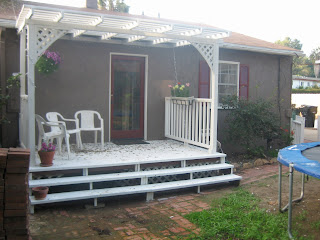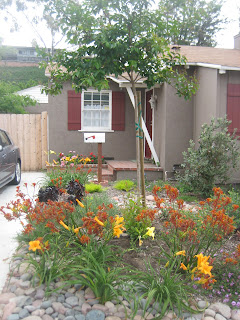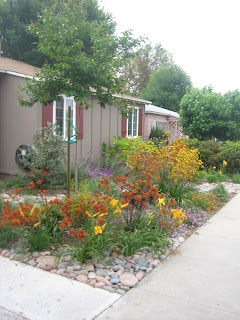One of the projects I've had on my list for the past year was to put some of my old brick pavers to use (the ones that were pulled up in the backyard when I landscaped) and build a nice, small patio to store my garbage bins on. One of those projects that is boring to everyone else, but has made me so happy ever since I finished it.
 |
| Repurposed, used brick pavers make for a cute patio. |
Previously, the bins rested on a bed of jagged little landscaping rocks which are not only ugly, but they were difficult to roll the bins on and off of and even worse, so many huge ugly weeds sprout up through the rocks. This is one of the few times, and it turns out the ONLY part of my house, that I don't have a before picture of.
How to Lay Pavers - The Non-Professional's Guide
This is the "I just need it to function" method. If I were serious, I would have made the ground completely level and used string and sticks and levels to make sure. And used something to cut a few bricks to size so my border doesn't have a gap at the back.
Instead, I worked off memory from a 3 part YouTube video I watched over a year ago on how to lay brick pavers and decided to see how it went. Because it was just too hard to spend 5 minutes watching the videos again.
Step 1: Prep Work
I paid my landscaper to dig out about four inches of dirt and rock because he does a good job of eyeballing level. And I learned when I had to dig a hole to bury my cat Boo that I hate digging.
Step 2: Lay Bricks
After I had a level, clear areas to work in, I poured about a quarter inch of landscaping sand (about $3/bag - I needed 6 bags for my roughly 5x7foot area). I didn't do it all at once - I just poured a little bit for the immediate area I was working on b/c it's nicer to work with while it's damp. Yes, it comes out of the bag damp. And yes, I'm just now realizing as I type this that I could have used the hose to re-moisten it if I had poured more.
Next I laid a border with my larger 12x12 pavers, tapping each into place with a rubber mallet.
Then I figured out a simple pattern for the brick sized pavers, again, using the mallet to tap them as close together as possible.
Last, I put a border around the border (see pictures) to try and hold everything in place.
 |
Click to enlarge - left side has sand in
the gaps, right side still needs sand. |
Step 3: Add SandThe final step is pouring sand into all the gaps and using a broom (and my hands) to brush it into the spaces between all the bricks. I did this twice - I noticed after a day that the first round of sanding had settled and I had more gaps again.
Step 4: Curb AppealOk, that wasn't the FINAL step. The final step was putting mulch/tanbark around the border b/c I didn't build all the way to the fence (because my landscaper didn't clear that far).
The final product:
 |
| It's done! I really like how the aged and used bricks look. |
 |
| The brick patio at work - a nice home for all my garbage bins. |
Total Cost: About $20 for bags of sand and $11 for a rubber mallet. Materials were free, however if you have to buy new pavers, these are about $.60/each.
































